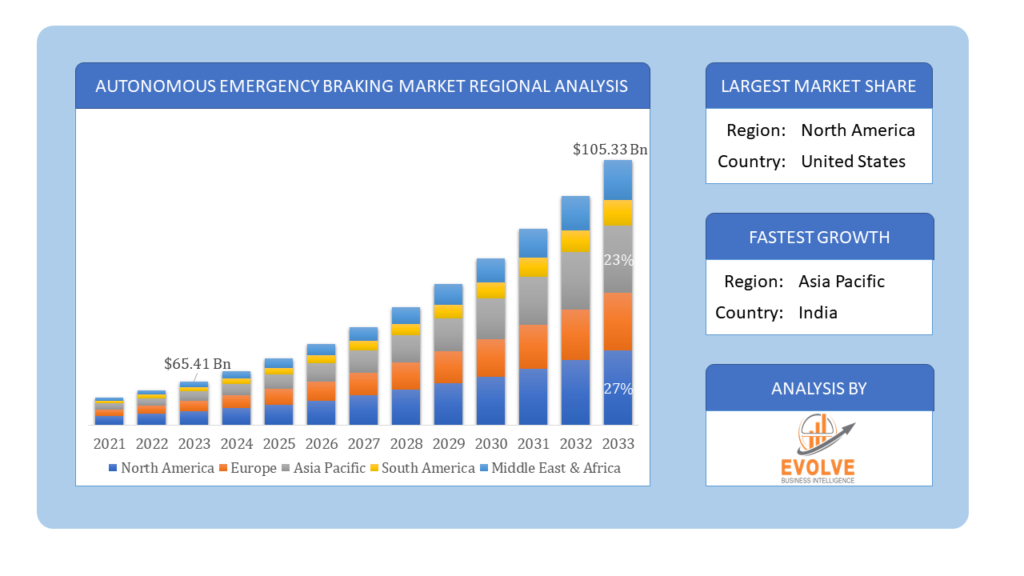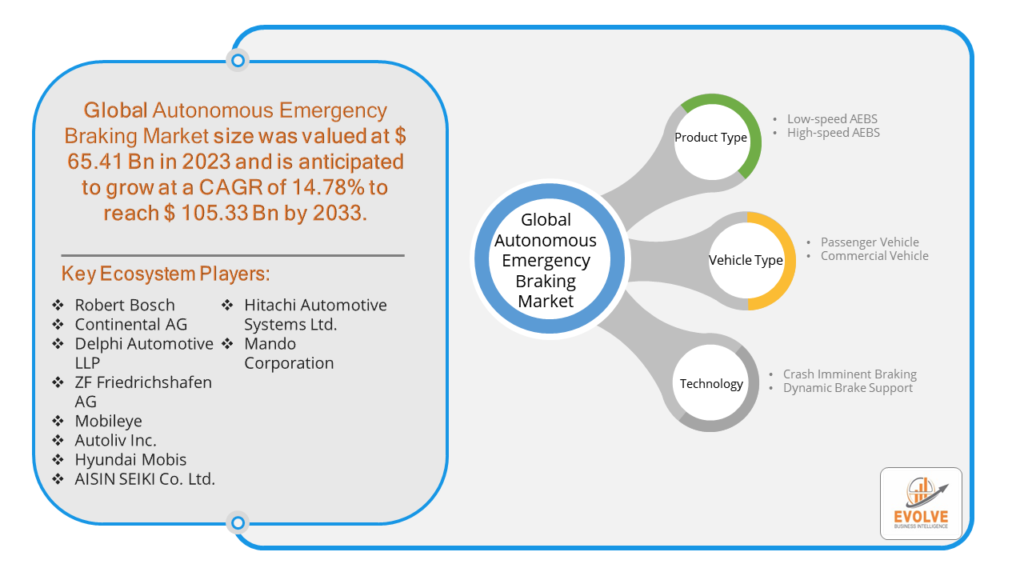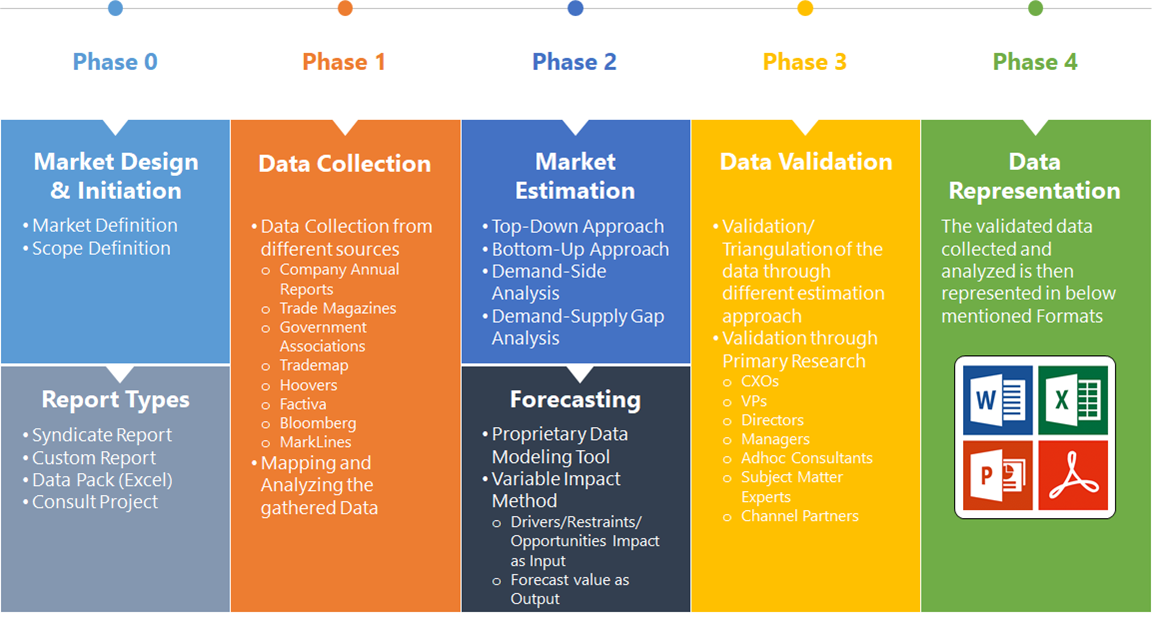Autonomous Emergency Braking Market Overview
The Autonomous Emergency Braking Market Size is expected to reach USD 105.33 Billion by 2033. The Autonomous Emergency Braking Market industry size accounted for USD 65.41 Billion in 2023 and is expected to expand at a compound annual growth rate (CAGR) of 14.78% from 2023 to 2033. The Autonomous Emergency Braking (AEB) Market refers to the sector focused on the development, production, and sale of AEB systems. These systems are designed to automatically detect an impending collision and activate the brakes to prevent or mitigate the impact without driver intervention. The market includes various components and technologies such as sensors, cameras, radar, and LiDAR, as well as software for vehicle detection and decision-making algorithms. It encompasses a wide range of vehicles including passenger cars, commercial vehicles, and others. The market’s growth is driven by increasing safety concerns, regulatory mandates, and advancements in automotive technology.
AEB systems utilize advanced sensors and technologies to detect potential collisions with objects or pedestrians. When an imminent collision is detected, the system automatically applies the brakes, reducing the vehicle’s speed and minimizing the impact or preventing it altogether. The AEB market is expected to witness significant growth in the coming years due to the increasing focus on road safety, technological advancements, and favorable government regulations.
Global Autonomous Emergency Braking Market Synopsis
The COVID-19 pandemic had a significant impact on the Autonomous Emergency Braking (AEB) Market. The pandemic disrupted global supply chains, affecting the production and distribution of AEB systems. This led to delays and increased costs for manufacturers. The automotive industry faced significant slowdowns in vehicle production due to lockdowns, social distancing measures, and reduced workforce availability. This directly impacted the demand for AEB systems. The economic downturn caused by the pandemic led to reduced consumer spending on non-essential items, including new vehicles equipped with advanced safety systems like AEB. The heightened awareness of health and safety during the pandemic extended to vehicle safety, potentially increasing interest in AEB systems among consumers and regulators. The pandemic accelerated the shift towards automation and contactless technologies, which could boost the adoption of AEB systems in the long run as part of broader vehicle automation trends.
Autonomous Emergency Braking Market Dynamics
The major factors that have impacted the growth of Autonomous Emergency Braking Market are as follows:
Drivers:
Ø Rising Awareness of Vehicle Safety
Growing awareness among consumers about vehicle safety features is driving demand for cars equipped with AEB systems. Consumers are increasingly prioritizing safety when purchasing new vehicles. Independent safety organizations like the Insurance Institute for Highway Safety (IIHS) and Euro NCAP include AEB in their safety ratings, influencing consumer choices and encouraging manufacturers to include AEB systems. Advances in sensor technologies, such as radar, LiDAR, and cameras, have improved the accuracy and reliability of AEB systems, making them more effective in preventing collisions. Integration of AI and machine learning algorithms in AEB systems enhances their ability to detect and respond to potential hazards more accurately and quickly. The broader trend towards vehicle automation and autonomous driving is boosting the adoption of AEB systems as a fundamental component of advanced driver assistance systems (ADAS).
Restraint:
- Perception of High Costs and Technical Limitations
The development, testing, and integration of AEB systems involve significant costs. This can make vehicles equipped with these systems more expensive, potentially deterring cost-sensitive consumers. AEB systems require regular maintenance and can be costly to repair if damaged, increasing the overall cost of vehicle ownership. AEB systems rely on sensors like cameras, radar, and LiDAR, which can be affected by adverse weather conditions such as heavy rain, fog, or snow, potentially reducing their effectiveness.
Opportunity:
⮚ Integration with Autonomous and Connected Vehicles
AEB is a critical component of ADAS, and its integration with other systems like adaptive cruise control and lane-keeping assist enhances overall vehicle safety. The growth of connected vehicle technologies provides opportunities for AEB systems to receive real-time data from other vehicles and infrastructure, improving their effectiveness. Commercial vehicle operators can benefit from AEB systems to enhance fleet safety, reduce accidents, and lower operational costs. Stricter safety regulations for commercial vehicles can drive the adoption of AEB systems in this segment. Developing retrofit AEB solutions for existing vehicles provides a significant opportunity to expand the market beyond new vehicle sales.
Autonomous Emergency Braking Market Segment Overview
By Product Type
 Based on Product Type, the market is segmented based on Low-speed AEBS and High-speed AEBS. The low-speed System segment dominates the market for automated emergency braking. Low-Speed AEB Systems are intended to prevent collisions at lesser speeds of up to 50 km/h (31 mph). They’re especially useful for parking and city driving because sensors identify obstructions and apply brakes as needed. Many modern autos are now equipped with low-speed AEB devices as standard equipment or as an optional feature.
Based on Product Type, the market is segmented based on Low-speed AEBS and High-speed AEBS. The low-speed System segment dominates the market for automated emergency braking. Low-Speed AEB Systems are intended to prevent collisions at lesser speeds of up to 50 km/h (31 mph). They’re especially useful for parking and city driving because sensors identify obstructions and apply brakes as needed. Many modern autos are now equipped with low-speed AEB devices as standard equipment or as an optional feature.
By Vehicle Type
Based on Vehicle Type, the market segment has been divided into the Passenger Vehicle and Commercial Vehicle. The passenger vehicles category dominates the market for automatic emergency braking. Recent passenger cars are frequently outfitted with ADAS, having AEB as either a standard or optional function. SUVs, cars, minivans, and other personal vehicles fall into this category. Recently, the industry has experienced a shift toward cleaner, lower-emission cars. Modern technologies are increasingly in demand, both inside and outside of the passenger vehicle industry.
By Technology
Based on Technology, the market segment has been divided into the Crash Imminent Braking and Dynamic Brake Support. The dynamic brake support segment dominate the automatic emergency braking market. The Dynamic brake Support (DBS) safety function is designed to assist drivers in emergency braking situations by raising brake pressure in response to unexpected braking occurrences.
Global Autonomous Emergency Braking Market Regional Analysis
Based on region, the global Autonomous Emergency Braking Market has been divided into North America, Europe, Asia-Pacific, the Middle East & Africa, and Latin America. North America is projected to dominate the use of the Autonomous Emergency Braking Market followed by the Asia-Pacific and Europe regions.
 Autonomous Emergency Braking North America Market
Autonomous Emergency Braking North America Market
North America holds a dominant position in the Autonomous Emergency Braking Market. The AEB market in North America is driven by stringent safety regulations and high consumer awareness of vehicle safety features. The National Highway Traffic Safety Administration (NHTSA) and the Insurance Institute for Highway Safety (IIHS) have been instrumental in promoting the adoption of AEB systems. The presence of leading automotive manufacturers and technology companies in the region fosters innovation and the development of advanced AEB systems. There is a significant opportunity for the adoption of AEB systems in commercial vehicle fleets to enhance safety and reduce accident-related costs.
Autonomous Emergency Braking Asia-Pacific Market
The Asia-Pacific region has indeed emerged as the fastest-growing market for the Autonomous Emergency Braking Market industry. Asia Pacific is the fastest-growing region in the AEB market, driven by rapid urbanization, rising disposable incomes, and increasing vehicle ownership. Growing consumer awareness of safety features, government initiatives to improve road safety, and a large automotive manufacturing base contribute to the market’s expansion. China and India are the key growth drivers in this region. China is one of the fastest-growing markets for AEB systems, driven by rapid urbanization, increasing vehicle ownership, and government initiatives to improve road safety. The Chinese government has been proactive in implementing safety regulations and promoting advanced driver assistance systems (ADAS).
Competitive Landscape
The global Autonomous Emergency Braking Market is highly competitive, with numerous players offering a wide range of software solutions. The competitive landscape is characterized by the presence of established companies, as well as emerging startups and niche players. To increase their market position and attract a wide consumer base, the businesses are employing various strategies, such as product launches, and strategic alliances.
Prominent Players:
- Robert Bosch
- Continental AG
- Delphi Automotive LLP
- ZF Friedrichshafen AG
- Mobileye
- Autoliv Inc.
- Hyundai Mobis
- AISIN SEIKI Co. Ltd.
- Hitachi Automotive Systems Ltd.
- Mando Corporation
Scope of the Report
Global Autonomous Emergency Braking Market, by Product Type
- Low-speed AEBS
- High-speed AEBS
Global Autonomous Emergency Braking Market, by Vehicle Type
- Passenger Vehicle
- Commercial Vehicle
Global Autonomous Emergency Braking Market, by Technology
- Crash Imminent Braking
- Dynamic Brake Support
Global Autonomous Emergency Braking Market, by Region
- North America
- US
- Canada
- Mexico
- Europe
- UK
- Germany
- France
- Italy
- Spain
- Benelux
- Nordic
- Rest of Europe
- Asia Pacific
- China
- Japan
- South Korea
- Indonesia
- Austalia
- Malaysia
- India
- Rest of Asia Pacific
- South America
- Brazil
- Argentina
- Rest of South America
- Middle East & Africa
- Saudi Arabia
- UAE
- Egypt
- South Africa
- Rest of Middle East & Africa
| Parameters | Indicators |
|---|---|
| Market Size | 2033: $105.33 Billion |
| CAGR | 14.78% CAGR (2023-2033) |
| Base year | 2022 |
| Forecast Period | 2023-2033 |
| Historical Data | 2021 |
| Report Coverage | Revenue Forecast, Competitive Landscape, Growth Factors, and Trends |
| Key Segmentations | Product Type, Vehicle Type, Technology |
| Geographies Covered | North America, Europe, Asia-Pacific, Latin America, Middle East, Africa |
| Key Vendors | Robert Bosch, Continental AG, Delphi Automotive LLP, ZF Friedrichshafen AG, Mobileye, Autoliv Inc., Hyundai Mobis, AISIN SEIKI Co. Ltd., Hitachi Automotive Systems Ltd. And Mando Corporation |
| Key Market Opportunities | • Integration with Autonomous and Connected Vehicles • Commercial Vehicle Market |
| Key Market Drivers | • Rising Awareness of Vehicle Safety • Technological Advancements |
REPORT CONTENT BRIEF:
- High-level analysis of the current and future Autonomous Emergency Braking Market trends and opportunities
- Detailed analysis of current market drivers, restraining factors, and opportunities in the future
- Autonomous Emergency Braking Market historical market size for the year 2021, and forecast from 2023 to 2033
- Autonomous Emergency Braking Market share analysis at each product level
- Competitor analysis with detailed insight into its product segment, Government & Defense strength, and strategies adopted.
- Identifies key strategies adopted including product launches and developments, mergers and acquisitions, joint ventures, collaborations, and partnerships as well as funding taken and investment done, among others.
- To identify and understand the various factors involved in the global Autonomous Emergency Braking Market affected by the pandemic
- To provide a detailed insight into the major companies operating in the market. The profiling will include the Government & Defense health of the company’s past 2-3 years with segmental and regional revenue breakup, product offering, recent developments, SWOT analysis, and key strategies.





